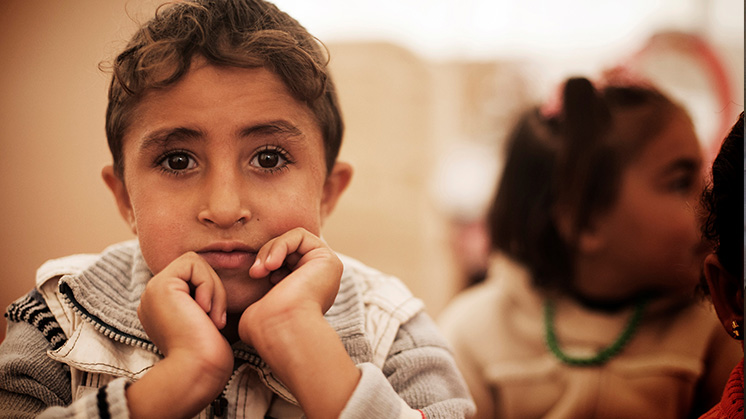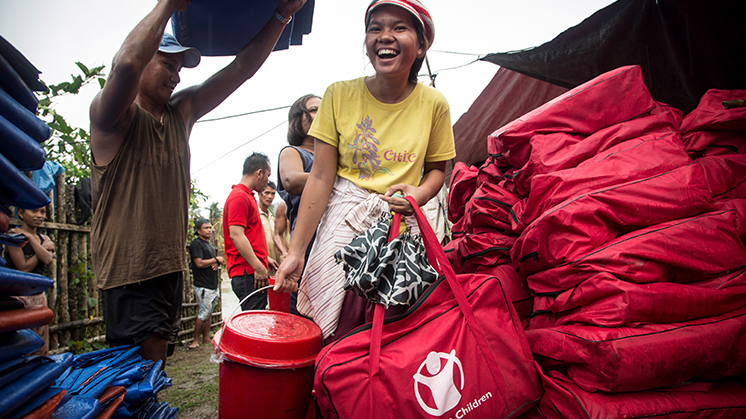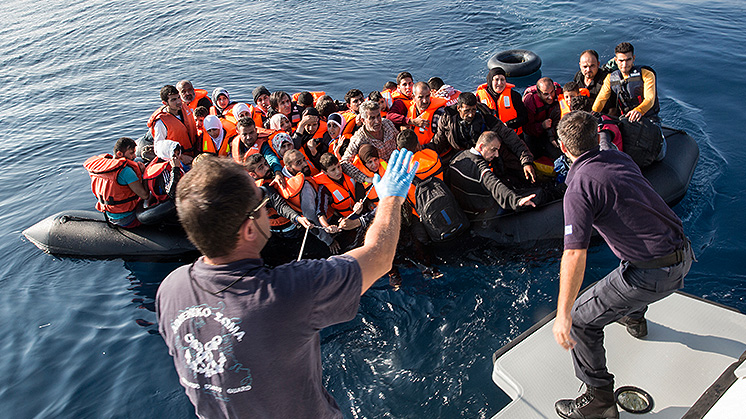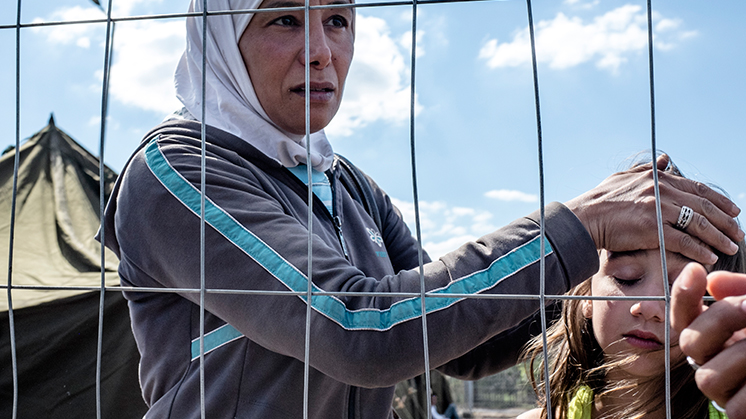 Aswini, four, at a tented settlement in Kamalbinayak, Bhaktapur, Nepal. Save the Children is providing displaced families essential items with infant kits, which include warm clothes, hats and blankets as well as essential hygiene kits.
Aswini, four, at a tented settlement in Kamalbinayak, Bhaktapur, Nepal. Save the Children is providing displaced families essential items with infant kits, which include warm clothes, hats and blankets as well as essential hygiene kits.
Image: Jonathan Hyams/Save the Children
FUNDING INTERNATIONAL HUMANITARIAN ASSISTANCE: WHAT PHILANTHROPISTS NEED TO KNOW
When an international humanitarian tragedy occurs, it often triggers a wave of funding for emergency on-the-ground relief. While humanitarian aid is critical, so is the role of advocacy in preventing further atrocities or stopping a bad situation from getting worse. After all, governments tend to be more proactive when they know they are being scrutinised.
Understanding how humanitarian assistance is provided and how humanitarian organisations are structured is an important step in making impactful funding decisions.
 Za'atari Refugee Camp, located 10kms from the Syrian border in Jordan. Save the Children run Rainbow Kindergarten at Za'atari Refugee Camp.
Za'atari Refugee Camp, located 10kms from the Syrian border in Jordan. Save the Children run Rainbow Kindergarten at Za'atari Refugee Camp.
Image: Jonathan Hyams/Save the Children
Today, the larger global aid organisations providing front line relief work are part of sophisticated global networks that can move quickly, and most importantly, have a local presence. “Having local staff on the ground is critical to understanding local cultures, customs and context,” explains Paul Ronalds, CEO of Save the Children Australia.
 Residence of a riverside village in Dolores, Eastern Samar, Philippines, receive essential aid items from Save the children after Typhoon Hagupit hit their village, Dolores, Eastern Samar, Philippines.
Residence of a riverside village in Dolores, Eastern Samar, Philippines, receive essential aid items from Save the children after Typhoon Hagupit hit their village, Dolores, Eastern Samar, Philippines.
Image: Jonathan Hyams/Save the Children
Save the Children is an international aid and development agency that is focused on protecting children from harm, with offices in 124 countries. Staggeringly, at any one time, they are responding to 50-60 global humanitarian crises.
“The need in a crisis always exceeds the availability of resources, which is why coordination is critical to limiting duplication and low impact activities.”
Paul Ronalds, CEO, Save the Children Australia
Coordination is key for saving lives in an emergency response. Understanding the United Nations (UN) emergency response mechanism to a crisis is also critical for an organisation wanting to maximise its impact on the ground as the relief coordination effort is generally under UN auspices. When Typhoon Haiyan devastated Central Visayas in the Philippines in 2013, a locally based UN resident coordinator worked closely with the Philippines government to drive a UN coordinated response.
 Residence of a riverside village in Dolores, Eastern Samar, Philippines, receive essential aid items from Save the children after Typhoon Hagupit hit their village, Dolores, Eastern Samar, Philippines.
Residence of a riverside village in Dolores, Eastern Samar, Philippines, receive essential aid items from Save the children after Typhoon Hagupit hit their village, Dolores, Eastern Samar, Philippines.
Image: Jonathan Hyams/Save the Children
Typically, the UN will delegate responsibilities for critical activities to some of the larger aid organisations. For example, Save the Children may be delegated responsibility for coordination of education and reestablishment of schools, Oxfam for water and World Vision for food aid. “It doesn’t mean each organisation is responsible for providing all the aid in that sector but rather that it is responsible for coordination in that sector so that there is no doubling up,” says Ronalds.
“For very high profile crises, it is not uncommon for 300 aid organisations to fly in to the crisis area with the best of intentions to provide aid. Realistically, only half a dozen understand how local coordination works and how to integrate their efforts for maximum impact.”
Paul Ronalds, CEO, Save the Children Australia
While crisis response work is critical in keeping people alive following a disaster, humanitarian advocacy is just as important. Often, however, advocacy is less visible and usually seeks longer-term solutions in alleviating human suffering.
ALLEVIATING HUMAN SUFFERING THROUGH ADVOCACY
Humanitarian advocacy is concerned with creating systemic changes that improve human rights outcomes. For Human Rights Watch, a global research and advocacy organisation, this process involves researching and documenting human rights abuses, lobbying policy makers to make positive changes, and sharing this information with the public.
 Members of the Hellenic Coast Guard rescue migrants and asylum seekers from an overcrowded rubber dinghy found drifting in the sea off Lesbos island in Greece. October 4, 2015
Members of the Hellenic Coast Guard rescue migrants and asylum seekers from an overcrowded rubber dinghy found drifting in the sea off Lesbos island in Greece. October 4, 2015
© 2015 Zalmaï for Human Rights Watch
“We believe it’s important for policy makers to make decisions that are informed by the plights of victims of abuse,” says Elaine Pearson, the Australian Director of Human Rights Watch. “We make clear recommendations of actions that policy makers should take, which are in line with international human rights standards.”With approximately 400 staff located in more than 90 countries and a highly regarded research team of former journalists, political scientists, lawyers and academics, Human Rights Watch has the influence to lobby governments and policy makers at the highest level.
Human Rights Watch has embraced the power of social media to get their message to the public and its twitter account has 2.3 million followers. In fact, one of the most haunting photographs to emerge from the Syrian refugee crisis in Europe was first tweeted by a Human Rights Watch staffer this year. The confronting photographs of drowned Syrian child, Aylan Kurdi, on a beach in Turkey galvanised public opinion in Australia and the world. It sparked a rapid policy response from the Australian government to increase the intake of Syrian refugees.
 Syrian asylum seekers in a detention center at the Hungarian border. September 9, 2015.
Syrian asylum seekers in a detention center at the Hungarian border. September 9, 2015.
© 2015 Zalmaï for Human Rights Watch
Human Rights Watch doesn’t accept government funds, directly or indirectly, or accept funds from private donors that could compromise its objectivity and independence. Its political independence is critical to its work.
VALUABLE INTERACTIONS BETWEEN ON-THE-GROUND AND ADVOCACY ORGANISATIONS
In seeking to alleviate human suffering, it’s important for different types of interventions to occur. Aid relief and advocacy organisations commonly work side-by-side during humanitarian crises to get the best outcomes.
“Front line relief aid is focused on getting emergency assistance to people with desperate humanitarian needs. Aid workers are often grateful that Human Rights Watch can speak to individuals and get important information out to the media and the public,” notes Elaine Pearson, the Australian Director of Human Rights Watch.
An integral part of Human Rights Watch advocacy work is to document the conditions in the home country that cause people to flee.
“Ultimately we want to create sustainable change. This means looking at the root causes of an issue and applying pressure for change ”
Elaine Pearson, Australian Director, Human Rights Watch
Ronalds agrees. “When you are seeking to challenge the existing power structures in a community or industry, you have to take a sophisticated approach. We work with advocacy groups to do some parts of the advocacy on our behalf. This is often supported by our learnings from being on the ground.”
Pearson observes that the large number of refugees arriving in Europe has exposed new human rights abuses. “We have been documenting police abuse towards migrants and refugees in Macedonia and have called out the EU on their approach of shifting the refugee burden to some countries that are not equipped to provide protection to refugees.”
HOW DONORS CAN CREATE THE GREATEST IMPACT IN A HUMANITARIAN CRISIS
Philanthropists aiming for the highest social return on their investment might consider the following approaches.
1. Invest earlyRonalds’ advice to funders is to invest as early as possible following a humanitarian crisis event. “We will save the most lives in the first week or two. Funding received early on can better assist with planning the aid.”
Even better, invest before the event or disaster occurs. “Donors seeking a significant social investment return should consider disaster risk reduction investments as the impact on outcomes are enormous.” Ronalds explains that Save the Children pre-empted the damage from the Solomon Island floods in 2014, by working with 63 communities before the floods to plan how and where crops should be planted and shelters secured. For these 63 communities, there was no food insecurity following the floods.
2. Invest in organisations with a track recordAccording to Ronalds, donors wanting to fund on-the-ground aid should look for organisations with a strong local history, and an understanding of the global UN humanitarian system and how to work within it. “Without those things, there is a high likelihood of the money being wasted,” he notes.
Pearson also urges donors to be sure that funded organisations have the capacity to deliver and are coordinated with the local relief effort.
3. Don’t focus on one type of intervention“It’s important for donors to know that the work of one organisation isn’t going to fix everything. Advocacy needs to match the work being done on the humanitarian front line. Especially where governments are not living up to their obligations,” says Pearson.
Ronalds agrees. “Some philanthropists are only interested in food aid. Certainly, in the immediate aftermath of a humanitarian crisis the focus is to save lives but it doesn’t support systemic changes or prevent the crisis from happening in the future.”
It is clear that a variety of interventions in humanitarian crises are needed. The timeframe for outcomes in on-the-ground aid and advocacy are quite different but they are both integral to alleviating human suffering.
“Our advice to philanthropists who wish to fund organisations working internationally is to find organisations who can speak of their effectiveness and track record as well as demonstrating efficiencies through local partnerships. For the clients we work with, they are keen to ensure that organisations they are supporting in development and human rights advocacy actually walk the talk", says Perpetual's National Manager of Philanthropy and Non Profit Services, Caitriona Fay.
